Geometry | Term 1 Chapter 5 | 7th Maths - Pair of Angles formed by Intersecting Lines | 7th Maths : Term 1 Unit 5 : Geometry
Chapter: 7th Maths : Term 1 Unit 5 : Geometry
Pair of Angles formed by Intersecting Lines
Pair
of Angles formed by Intersecting Lines
We are going to study related angles such as adjacent
angles, linear pair of angles and vertically opposite angles.
1.
Adjacent angles
The
teacher shows a picture of sliced orange with angles marked on it.
Read
the conversation between the teacher and students.
Teacher
: How many angles are marked on the picture? Can you name them?
Kavin
: Three angles are marked on the picture. They are ∠AOC, ∠AOB and ∠BOC
Teacher
: Which are the angles seen next to each other?
Thoorigai
: Angles such as ∠AOB and ∠BOC are next to each other.
Teacher
: How many vertices are there?
Mugil
: There
is only one common vertex.
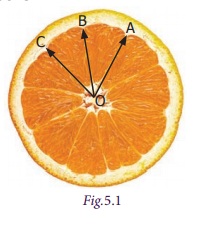
Teacher
: How many arms are there? Name them.
Amudhan
: There are three arms. They are ![]() , OB and
, OB and ![]()
Teacher
: Is there any common arm for ∠AOB and ∠BOC?
Oviya
: Yes. ![]() is the common arm for ∠AOB and ∠BOC.
is the common arm for ∠AOB and ∠BOC.
Teacher
: What can you say about the arms ![]() and
and ![]() ?
?
Kavin
: They lie on the either side of the common arm ![]() .
.
Teacher
: Are the interiors of ∠AOB and ∠BOC overlapping?
Mugil
: No. Their interiors
are not overlapping.
Teacher
: Hence the two angles, ∠AOB and ∠BOC have one common vertex (O), one
common arm (![]() ), other two
arms (
), other two
arms (![]() and
and ![]() ) lie on either side of the common arm and their interiors do not overlap.
) lie on either side of the common arm and their interiors do not overlap.
Such pair of angles ∠AOB and ∠BOC are called adjacent
angles.
So, two angles which
have a common vertex and a common arm, whose interiors do not overlap are called
adjacent angles.
Now
observe the Fig.5.2 in which angles are named ∠1, ∠2 and ∠3.
It
can be observed that there are two pairs of adjacent angles such as ∠1, ∠2 and ∠2, ∠3. Then what about the pair of angles
∠1 and ∠3?
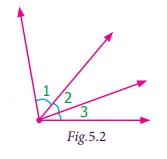
They
are not adjacent because this pair of angles have a common vertex but they do not
have a common arm as ∠2 is in between
∠1 and ∠3. Also interiors of ∠1 and ∠3 do not overlap. Since the pair of
angles does not satisfy one among the three conditions they are not adjacent.
Think
In each of the following figures, observe the pair of angles that
are marked as ∠1 and ∠2. Do you think that they are adjacent
pairs? Justify your answer.

Try these
1. Few real life examples depicting adjacent angles are shown below.

Can you give three more examples of adjecent angles seen in real
life?
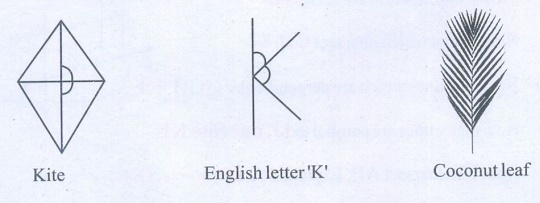
2. Observe the six angles marked in the picture shown. Write any
four pairs of adjacent angles and that are not.
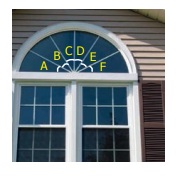
adjacent angles ∠A and ∠B, ∠B and ∠C
∠C and ∠D, ∠D and ∠E
∠E and ∠F
Not adjacent angles
∠Aand ∠C
∠B and ∠D
∠C and ∠E
∠Dand ∠F
∠Aand ∠D
3. Identify the common arm, common vertex of the adjacent angles
and shade the interior with two colours in each of the following figures.


4. Name the adjacent angles in each of the following figure.

(i) ∠BAC and ∠CAD
(ii) ∠ZWY and ∠YWX
2.
Linear pair
Observe
the Fig.5.3 ∠QPR and ∠RPS are adjacent angles. It is clear
that ∠QPR and ∠RPS together will make ∠QPS which is acute. When ∠QPR and ∠RPS are increased ∠QPS becomes (i) right angle, (ii)
obtuse angle, (iii) straight angle and (iv) reflex angle as shown in Fig.5.4.
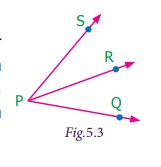
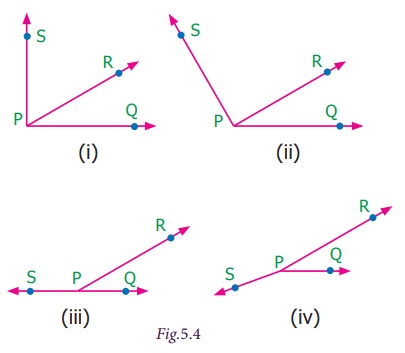
If the resultant angle is a straight angle then
the angles are called supplementary angles. The adjacent angles that are supplementary
lead us to a pair of angles that lie on straight line (Fig.5.4(iii)). This pair
of angles are called linear pair of angles.
Try these
1. Observe the following pictures and find the other angle of linear
pair.

The other angle (i) 96° (ii) 94° (iii) 21o
Think
Observe the figure. There are two angles namely ∠PQR = 150° and ∠QPS = 30°. Is all this pair of supplementary
angles a linear pair? Discuss.

Example 5.1 In Fig. 5.5, find ∠AOC.
Solution
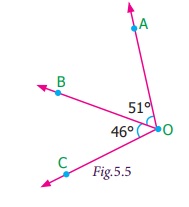
∠AOC = ∠AOB + ∠BOC
= 46° + 51°
= 97°
Example 5.2 If
∠POQ = 23° and ∠POR = 62° then find ∠QOR
Solution
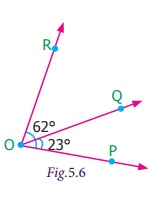
We know that ∠POR = ∠POQ + ∠QOR
62° = 23° + ∠QOR
Subtracting 23° on both sides
62° – 23° = 23° + ∠QOR – 23°
∠QOR = 39°
Example 5.3 Which of the following pair of adjacent
angles will make a linear pair?
(i)
89°, 91°
(ii) 105°, 65° (iii) 117°, 62° (iv) 40°, 140°
Solution
(i) Since 89° + 91°
= 180°, this pair will be a linear pair.
(ii) Since 105° + 65°
= 170° ≠ 180°, this pair cannot make a linear pair.
(iii) Since 117° + 62°
= 179° ≠ 180°, this pair cannot make a linear pair.
(iv) Since 40° + 140°
= 180°, this pair will be a linear pair.
Example
5.4 Find the missing angle.

Solution
(i) Since the angles are linear pair,
∠ACD +
∠BCD = 180°
123° + ∠BCD = 180°
Subtracting 123° on both sides
123° + ∠BCD – 123° = 180° – 123°
∠BCD = 57°
(ii) Since the angles are linear pair, ∠LNO + ∠MNO = 180°
46° + ∠MNO = 180°
Subtracting 46° on both sides
46° + ∠MNO – 46° = 180° – 46°
∠MNO = 134°
Example 5.5 Two angles are in the ratio 3:2. If
they are linear pair, find them.
Solution
Let the angles be 3x and 2x
Since they are linear pair of angles, their sum
is 180°.
Therefore, 3x+2x = 180°
5x = 180°
x = 180º / 5
x = 36°
The angles are 3x = 3×36 = 108°
2x = 2×36
= 72°
More
on linear pairs
Amudhan asked his teacher what would happen if he
drew a ray in between a linear pair of angles? The teacher told him to draw it.
Amudhan drew the ray as shown in Fig.5.8.
Teacher asked Amudhan, "what can you say about
the angles ∠AOB and ∠BOC?". He said that they are adjacent angles.
Also it is true that ∠AOB + ∠BOC = ∠AOC.
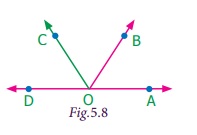
The teacher also asked about the pair of angles
∠AOC and ∠COD. He replied that they are linear pair. Therefore,
their sum is 180° i.e. ∠AOC + ∠COD = 180°.
Combining these two results we get ∠AOB + ∠BOC + ∠COD = 180°.
Thus, the sum of all
the angles formed at a point on a straight line is 180°.
Think
What would happen to the angles if we
add 3 or 4 or 5 rays on a line as given below?

We can learn one more result on linear pairs.
Observe the following Fig.5.9.
AB is a straight line. OC is a ray meeting AB at
O.
Here, ∠AOC and ∠BOC are linear pair.
Hence ∠AOC + ∠BOC = 180°
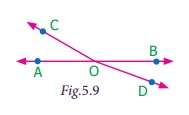
Also, OD is another ray meeting AB at O.
Again ∠AOD and ∠BOD are linear pair.
Hence ∠AOD + ∠BOD = 180°
Now, ∠AOC, ∠BOC, ∠AOD and ∠BOD are the angles that are formed at the point O.
We can observe that (∠AOC + ∠BOC) + (∠AOD + ∠BOD) = 180° + 180° = 360°.
So, the sum of the angles
at a point is 360°.
Think
Can you justify the following statement.
∠AOB + ∠BOC + ∠COD + ∠DOE + ∠EOF + ∠FOA = 360°?

Example 5.6 From Fig.5.10, find the measure of ∠ROS.
Solution
We know that ∠QOR + ∠ROS + ∠SOP = 180°
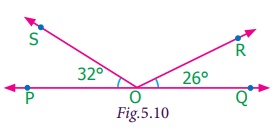
26° + ∠ROS + 32° = 180°
∠ROS + 58° = 180°
Subtracting
58° on both sides
We get, ∠ROS = 180° – 58° = 122°
Example 5.7 In Fig. 5.11, find the value of x°
Solution
98° + 23° + 76° + x° = 360°
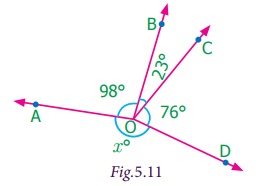
197° + x° = 360°
x° =
360° − 197° = 163°
3.
Vertically opposite angles
We have already studied about intersecting lines.
Observe the Fig.5.12. There are two lines namely l and m which are intersecting at a point O and forming four angles at that point of intersection. They are ∠1, ∠2, ∠3 and ∠4.
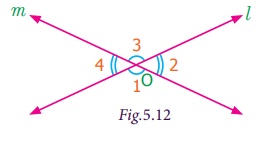
Consider any one angle among this say ∠1. The angles which are adjacent to ∠1 are ∠2 and
∠4, ∠3 is a non-adjacent angle. Similarly, for the remaining
three angles two angles will be adjacent and one angle will be non-adjacent. We
can observe that an angle and its non-adjacent angle are just opposite to each other
at the point of intersection O (vertex). Such angles which are opposite to each
other with reference to the vertex are called vertically opposite angles.
When two lines intersect each other,
two pairs of non-adjacent angles formed are called vertically opposite angles.
Try these
1. Four real life examples for vertically
opposite angles are given below.

Give four more examples for vertically
opposite angles in your surrounding.

2. In the given figure, two lines ![]() and
and ![]() intersect at O. Observe the pair of angles and complete
the following table. One is done for you.
intersect at O. Observe the pair of angles and complete
the following table. One is done for you.

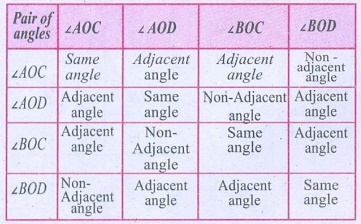
3. Name the two pairs of vertically
opposite angles.
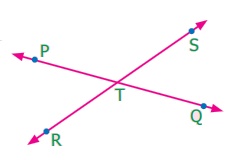
∠ PTS and ∠ RTQ
∠ PTR and ∠ STQ
4. Find the value of x° in the figure
given below.
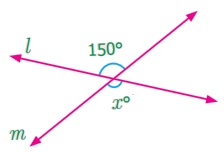
xo = 150o
Activity
On a paper draw two intersecting lines ![]() and
and ![]() . Let the two lines intersect at
O. Label the two pairs of vertically
opposite angles as ∠1, ∠2 and ∠3, ∠4. Make
a trace of angles ∠2 and
∠3. Place
the traced angle ∠2 on angle ∠1. Are
they equal? Place the traced angle ∠3 on angle ∠4. Are
they equal? Continue the same for five different pair of intersecting lines. Record
your observations and discuss.
. Let the two lines intersect at
O. Label the two pairs of vertically
opposite angles as ∠1, ∠2 and ∠3, ∠4. Make
a trace of angles ∠2 and
∠3. Place
the traced angle ∠2 on angle ∠1. Are
they equal? Place the traced angle ∠3 on angle ∠4. Are
they equal? Continue the same for five different pair of intersecting lines. Record
your observations and discuss.
Related Topics